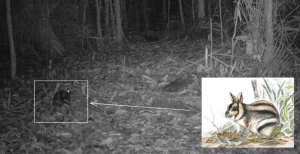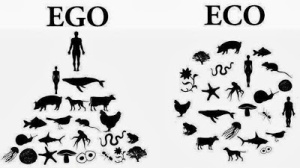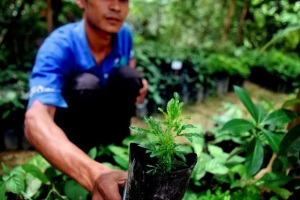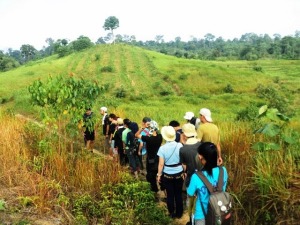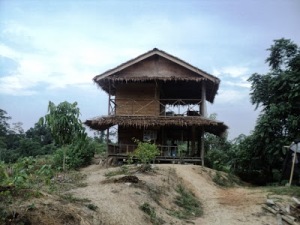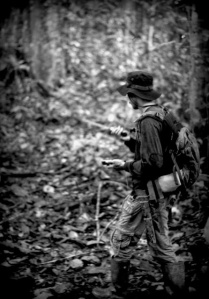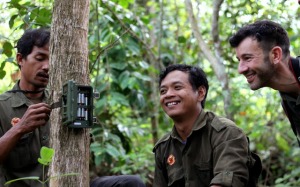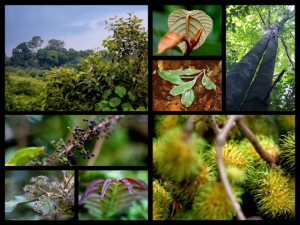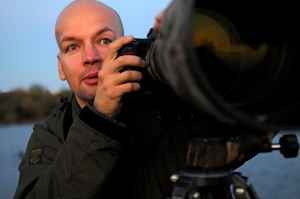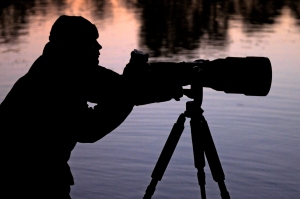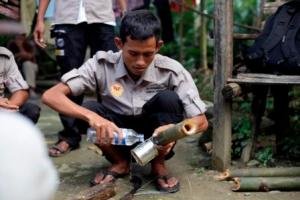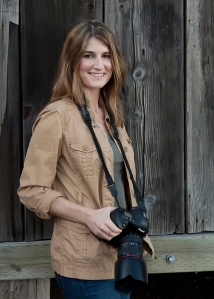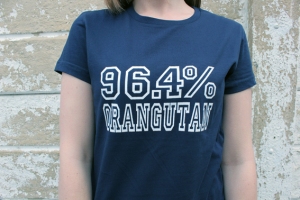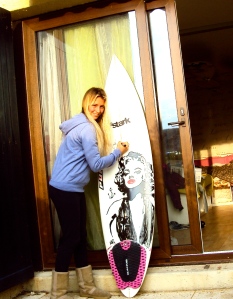The Gunung Leuser National Park is one of the only places in the world where you can still see the Sumatran orangutan in the wild. They share these forests with a whole host of other wildlife: gibbons, elephants, hornbills, Thomas leaf monkeys, macaques, sunbears, and the elusive Sumatran tiger are just a handful of the thousands of animal and plant species found in this unique World Heritage ecosystem. Deborah Williams from Alaska writes about her recent trek in search of the red ape…
For our vacation, we wanted to visit our red-haired relatives, the only ones who live in trees. With his red hair, my husband Rance always had a special affinity for orangutans; and I have always been fascinated by our fellow primates.

Deborah next to some huge buttress roots in the Gunung Leuser National Park.
To our delight we not only experienced many orangutans, but also Thomas leaf monkeys, 5-foot monitor lizards, rhinoceros hornbills, Lar gibbons, long-tailed macaques, glorious butterflies, extraordinary flora, abundant cool and clear rivers and streams, fabulous Indonesian food, and amazing Indonesian guides. The operative word is experience because all senses are involved: the Tarzan sound-track jungle sounds, the earthy and pungent smells, the heat and humidity, the verdant green views near and far, and even the tastes.
From our balcony in Bukit Lawang, a lively and charming village situated across the river that demarcates the national park, we could look across the river and watch bright orangutans making nests in the tree tops or slowly swinging between the trees, while dozens of mischievous long-tailed macaque monkeys made their way from the park to village.
There used to be a rehabilitation center for orangutans near the park entrance, and since there is still a feeding platform for a few orangutans who have not yet made a complete transition into the wild, visitors are likely to see orangutans during the twice daily feeding periods. Over time, most rehabilitated orangutans have ventured deeper into the park.

Deborah ventured deep into the park for a chance to spot its unique wildlife.
Our guides’ keen eyesight, hearing, and sense of smell ensured that we saw the jungle’s hidden treasures. We discovered a group of the stunning punk-haired Thomas’ leaf monkeys, a well camouflaged peacock, and a 5-foot monitor lizard swimming down a stream. We smelled the sweet resin from the towering damar tree, and learned about many other of the over 4,000 amazing plant species in the park. The views are magnificent and although the hiking is challenging, quitting was not an option. The jungle and its inhabitants were simply too compelling.
Two of our favorite sounds were the hoot-laugh of the rhinoceros hornbill and the distinctive call of the Lar gibbon. We hiked up and down cliffs to reach these elusive and amazing animals to catch a glimpse of them before they flew away with immense wings (the mate-for-life hornbills) or flitted quickly across tree tops (the Lar gibbon). Blue, yellow, red, orange, white, black, and purple butterflies were everywhere, especially near the rivers and streams. At night, the fireflies illuminated the sky with dancing points of light.
The star attractions, of course, were the orangutans, the largest tree-inhabiting mammal on earth. They are stronger, more graceful, and more emotionally intense than we had anticipated; and we quickly appreciated their name, which in Malay means ‘person of the forest’. At up to 175 pounds, with an arm span of almost 7 feet, orangutans are stunningly impressive, especially with their long orange-red hair in sharp contrast to the verdant green around them. The only great ape to live in trees, orangutans share 96.4% of our genetic heritage. When you look into their eyes, this common heritage is deeply felt.
The food on our trek was utterly delicious, and each night we enjoyed an Indonesian feast of 6 or 7 local dishes — like pumpkin curry, spicy fish and tofu, fried tapioca chips, sautéed local ferns and shoots, and other delicacies.
On the last day of our jungle trek, after visiting a beautiful waterfall, we loaded our gear into inner tubes and rafted down the sparkling, cool river to Bukit Lawang.

Sparkling, clear, cool rivers are a welcome sight.
On our final morning, across the river, two orangutans gracefully swung from tree-to-tree before starting to make a nest. Given the timing, there was a sense of “remember us please,” which could be interpreted as “do not let us go extinct on your watch.”
There are many ways to help improve the odds that our red-haired cousins will survive, including injecting tourism dollars into the local economies to provide livelihoods for Indonesians. Without deliberate action, the Sumatran orangutan will become extinct, and we will have destroyed the first great ape. We can do better; and by visiting Gunung Leuser National Park we can have an extraordinary time doing it.
If you would like to follow in Deborah’s footsteps, join an SOS expedition to the breathtaking Leuser forests. Click here for departure dates and booking information.
